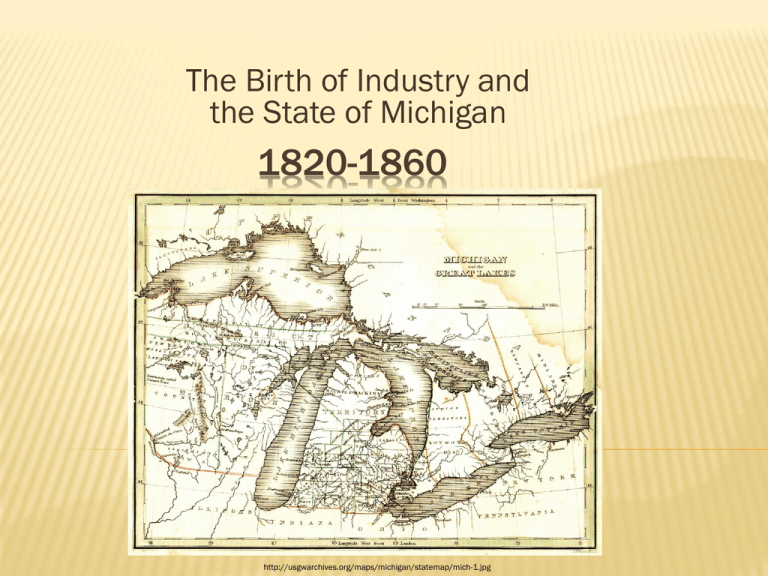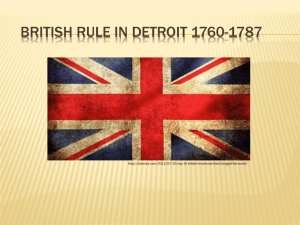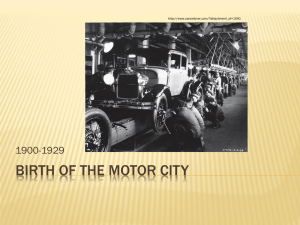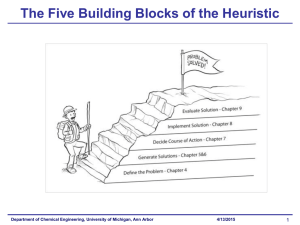
The Birth of Industry and
the State of Michigan
1820-1860
http://usgwarchives.org/maps/michigan/statemap/mich-1.jpg
http://en.wikipedia.org/wiki/Fort_Kiowa
THE FINAL ERA OF THE FUR TRADE
1815-1850
John Jacob Astor and the American Fur Company (AFC)
dominated postwar fur trade, even against the rival
British North West Company.
1822 – Congress ended government “factories,” and
Astor squeezed independent traders by selling goods to
Indians at very low prices in exchange for furs.
Gov. Lewis Cass was a friend and assisted him to
maintain monopoly. AFC controlled 95% of fur trade.
By mid-1830s, fur trading center was St. Louis, not
Mackinac, and Astor sold the AFC. Silk hats replaced
fur hats in the 1840s.
The AFC went out of business in 1842, and split into
several companies that went out of business in the
1850s.
The Astor family
invested in real
estate after the
end of the fur
trade.
THE ERIE CANAL OPENS (1825)
-
-
The canal links Lake Erie to the Hudson River in the east. 363
miles from Albany, NY to Buffalo, NY. Now called the New York
State Canal System.
It cost $7 million to build, and paid for itself in 3 years
It included 18 aqueducts to carry the canal over ravines and
rivers, and 83 locks, with a rise of 568 feet.
Cut transport costs by 95%
http://www.answers.com/topic/erie-canal
http://www.eriecanalvillage.net/
Erie Canal Village in Rome, NY is an outdoor living histor
museum reconstructed to 1817
IMPACT OF THE ERIE CANAL ON MICHIGAN
Did not cause an immediate rush to Michigan,
but facilitated movement
Brought many settlers from Western New York
to Michigan (Troy, Rochester, Utica, New
Buffalo)
http://en.wikipedia.org/wiki/Erie_Canal
ERIE CANAL SONG
(LOW BRIDGE, EVERYBODY DOWN)
I've got a mule, and her name is Sal,
Fif-teen miles on the Er-ie canal,
She's a good ol' worker and a good ol' pal,
Fifteen miles on the Er-ie can-al,
We've hauled some barges in our day,
Filled with lum-ber coal and hay,
And we know ev'ry inch of the way
From Al-ba-ny to Buff-a-lo OH
Chorus
Low bridge ev'-ry bod-y down,
Low bridge for we're com-in to a town,
And you al-ways know your neighbor,
You'll always know your pal,
If you've ev-er navigated on the Er-ie can-al
“CORDUROY” ROADS
1827 – Detroit to Toledo road completed at federal cost
of $32,000
1827 – Congress approves funds for “Chicago Road”
on parts of Old Sauk Trail (now U.S.-12) to link Fort
Dearborn in Chicago to Detroit
1829 – Congress approves funds for “Territorial Road”
from Ypsilanti to St. Joseph (now I-94)
1829 – Congress approves funds for road from Detroit
to Fort Gratiot (now Port Huron)
1829 – Congress approves funds for road from Detroit
to Saginaw
Although winding and very rugged, roads provided
traveler with a route along which taverns and towns
sprung up
http://thishouse.ca/63wales_maps_mls.htm
http://iarchives.nysed.gov/dmsBlue/viewImageData.jsp?id=80322
FACTORS SLOWING MICHIGAN GROWTH
Sandy soils where pine trees grow vs. rich soil
of the plains in Illinois
Railroad construction slow due to lakes on both
sides of the Lower Peninsula
Lumbering didn’t become important until after
1860
1830’S – “MICHIGAN FEVER”
1830 – 147,062 acres sold
1834 – 498,423 acres sold
1836 – 4,189,248 acres sold (mostly in
western Michigan)
Speculators bought most of land for $1.25 per
acre, and sold it to settlers for at least
$2.50/acre
Need 60,000 adults to become a state
POPULATION BOOM IN MICHIGAN AND DETROIT
1820 – 8,765 (1,422 in Detroit)
1830 – 31,639 (2,222 in Detroit)
1840 – 212,267 (9,192 in Detroit) (1830’s =
largest population growth of any decade in state
history = 7x increase) (Detroit had 4x increase)
1850 – 397,654 (21,019 in Detroit)
1860 – 749,113 (45,619 in Detroit)
Most people arrive in Detroit by water, then took
wagon into interior
http://en.wikipedia.org/wiki/Herman_Kiefer
GERMAN IMMIGRANTS
First wave to Detroit started in 1825.
Catholics (Lutherans) who spoke German
Hard workers, but tended to be Socialists, who
preferred strikes
1845 – established Frankenmuth (15 colonists
bought 680 acres for $1,700)
1847 – Frankentrost (22 families settled 6
miles north of Frankenmuth)
1848 – Frankenlust (22 miles north of
Frankenmuth)
1850 – Frankenhilf (called Richville today)
Most famous was Dr. Herman Kiefer, who
emigrated from Germany in 1849. Member of
Detroit Board of Education, and a regent at U of
M.
Most went to Wisconsin, searching for cheap
land
Herman Keifer Health
Complex houses the
Department of Vital Records.
It was once a hospital for
polio, TB, diphtheria, and
other diseases before these
patients were allowed in
other hospitals.
http://voiceofdetroit.net/2013/04/18/detroit-city-council-says-yes-to-banks-in-jones-day-vote-people-say-no/herman-kiefer-health-complex-3/
http://en.wikipedia.org/wiki/Corktown,_Detroit
IRISH IMMIGRANTS
Start arriving in Detroit in 1830.
Fled the Irish Potato Famine 1845-1852
Catholic, not Protestant like most
residents
Accent and poverty made them stick out
Moved to cities, working as railroad
laborers or domestic servants or opened
their own businesses.
Anti-English, so aided the Canadians in
1837-1842 Patriot’s War
Corktown is the
oldest neighborhood
in Detroit
COUNTIES
38 counties by 1837 (Only 1 county in 1796)
Wayne County (23,400 = 13% of state) Detroit
had 9,000 (38% of Wayne Co.). In 1827, Wayne
County was divided into 9 townships.
Washtenaw Co. (21,817) – Chippewa word for
“grand river” = Huron River
Oakland Co. (20,176) – named for oak openings
Lenawee Co. (14,540) – Shawnee word for
“Indian”
10 LARGEST TOWNS IN 1837
Detroit (city)
Ann Arbor
Monroe
Tecumseh
Ypsilanti
Adrian
Marshall
Pontiac
Grand Rapids
Niles
http://www.netstate.com/states/geography/mapcom/mi_mapscom.htm
TERRITORIAL GOVERNMENT
In 1823, Congress transferred governance of the Territory
of Michigan to the governor (appointed by the President)
and legislative council comprised of 9 members. No house
of representatives or “general assembly” was set up as
required by NW Ordinance.
Had non-voting delegate in Congress until became a state
Voting restricted to men who owned at least 50 acres of
land, and had lived in area for at least 2 years
1823-28 - Territorial capitol building was built on Griswold
Street. After the capital of Michigan moved to Lansing, the
former capitol was a public high school until 1893, when it
burned down. The land is now called Capitol Park, a
historic district bounded by Griswold, Shelby, and State
streets.
The Capitol,
circa 1847
http://www.hal.state.mi.us/mhc/timetraveler/statehood/todo.html
EARLY CONGRESSIONAL REPRESENTATIVES
http://en.wikipedia.org/wiki/William_Woodbridge
William Woodbridge
Solomon Sibley
Col. John Biddle (brother of
Nicholas Biddle, president of the
Second Bank of the United States)
Gabriel Richard (only Catholic
priest in Congress until 1970).
Richard died in 1832 from cholera
outbreak in Detroit.
Woodbridge was the
secretary of the
territory from 18181830. He later
became a U.S.
Senator after 1837.
He became governor
in 1840, but left
office for the US
Senate.
JOHN R. WILLIAMS
First elected mayor of Detroit in 1825. He was elected
mayor five times: in 1824, 1830, and 1844, 1845, and
1846. Before he died, he named “John R” road in his
honor. He wrote the City Charter in 1824.
He and his uncle Joseph Campau founded the Detroit
Free Press in 1831.
Was a delegate at the first Michigan Constitutional
Convention in 1835.
One of the first trustees of U of M.
President of the Detroit Board of Education
Williams served in the War of 1812, and
as a brigadier general in the Black Hawk
War of 1832.
http://en.wikipedia.org/wiki/List_of_mayors_of_Detroit
SHIP-BUILDING
1827 – Oliver Newberry starts ship-building industry in Detroit
with the Argo in 1927. The largest steamer was the Michigan
built in 1833 (below).
Built docks, warehouses, stores, offices, and a ship building yard
along Detroit’s waterfront
By 1850, shipping was Detroit’s biggest industry.
Newberry’s nephew, John S. Newberry, would later greatly
expand the shipping industry in Detroit
http://www.maritimehistoryofthegreatlakes.ca/documents/hgl/default.asp?ID=c023
STEVENS T. MASON (THE BOY GOVERNOR)
Replaced Gov. Lewis Cass in 1831 (19 years old) as
temporary acting governor when Cass became
Andrew Jackson’s Secretary of War
Jackson appointed George B. Porter (1831-1834) as
new governor, but he was frequently absent over next
three years, so Mason filled in. In 1834, Porter got
cholera, and Mason officially took power.
In Nov. 1834, Jackson appointed Henry Gilpin to be
governor, but the U.S. Senate rejected him, and then
Jackson tried to appoint Charles Shaler, but Shaler
declined. Jackson appointed John Horner, but he
was ignored by Michigan officials, who liked Mason.
Punched an editor once for calling him the “Boy
Governor”
http://www.gutenberg.org/files/21532/21532-h/21532-h.htm
http://en.wikipedia.org/wiki/Stevens_T._Mason
MASON PUSHES STATEHOOD
Population doubled from 1830 to 1833, so had
over 60,000 residents necessary for statehood.
Enabling Act = Congress grants territories the
power to become a state with own legislature,
laws, and taxes.
1834 – Acting Gov. Mason calls for a census, and
asks Territorial Council to call a constitutional
convention, elect a representative and two
senators, and demand admission to the Union
(Tennessee did the same in 1796). Census
showed 92,000.
CONSTITUTIONAL CONVENTION
May 11, 1835 – 91 elected delegates (half
were farmers, only 10 were lawyers) meet in
Detroit for constitutional convention. In only 45
days, they had a constitution.
Created a “bill of rights,” and bicameral
legislation with house (48-100 members
elected annually) and senate with 1/3 as many
members elected biannually
MICHIGAN CONSTITUTION OF 1835
Tried to restrict to landowners, but agreed to
everyone over 21 with 6 months’ residency.
State Superintendent of Public Instruction (first
state to establish this position, which could not
be abolished for any reason)
Funds from land sales MUST be used for
schools, and put in perpetual primary school
fund (interest used for schools)
Section 16 lands varied greatly
MICHIGAN CONSTITUTION OF 1835
Internal improvements: roads, railroads, canals
Governor, Lieutenant Gov., and legislators are
elected, not appointed (elections held in oddnumber years to avoid national elections)
Praised for its simplicity
Michigan rewrote entire Constitution several
times: 1850, 1908, 1963. These limited the
power of government as scandals arose, and the
public lost faith in their elected officials.
12 DIFFERENCES BETWEEN CONSTITUTIONS
MICHIGAN CONSTITUTION OF 1835
White males over 21
No min. age to be legislator
Either house can start bill
Governor has 2 year term
Gov must be U.S. citizen 5 years
State Reps have 1 year term
S.C. Justices have 7 year term
Seat of Gov’t TBD in 10 years
Amendments with 2/3 of both
houses, then majority of people
No slavery allowed
Mentions “Almighty God”
Legislative powers left vague
U.S. CONSTITUTION OF 1787
Doesn’t define voter
25 to be Rep, 30 to be Sen.
Bills start in House of Reps
President has 4 year term
Pres must be U.S. citizen 14 years
State Reps have 2 year term
S.C. Justices have life term
N/A
Amendments with 2/3 of both
houses, then ¾ of states
No mention of slavery
No mention of God
Legislative powers spelled out
NOV. 1, 1835 – GOVERNMENT BEGINS
http://en.wikipedia.org/wiki/John_Biddle_(Michigan_politician)
Stevens T. Mason (Democrat)
vs. John Biddle (Whigs) of the
land office in Detroit for
Governor.
Andrew Jackson replaced
Mason with John Horner
(“Little Jack”), who was
ignored for 9 months from
Sept. 1835 – July 1836
http://www.gutenberg.org/files/21532/21532-h/21532-h.htm
Horner was not in favor of statehood for Michigan. He released
Ohioans who were jailed for trespassing during Toledo Strip
Dispute. He was only in “power” for 9 months.
http://en.wikipedia.org/wiki/John_S._Horner
NEW GOVERNMENT
Constitution adopted with 83% of vote, and
Mason won with 90% of vote
Legislature selected two U.S. senators:
Lucius Lyon and John Norvell. Until
statehood in 1837, they were “spectators”
who couldn’t talk or vote
In March 1836, created a state supreme
court and judicial system
John Norvell was a
U.S. Senator from
1835 to 1841.
http://en.wikipedia.org/wiki/John_Norvell
Lucius Lyon was a
U.S. Senator from
1835 to 1839
http://en.wikipedia.org/wiki/Lucius_Lyon
http://usgwarchives.org/maps/michigan/statemap/mich-1.jpg
BORDER DISPUTES
Northwest Ordinance of 1787 made Michigan’s
southern boundary run east-west from tip of Lake
Michigan
Indiana became state in 1816, and asked
Congress to push border 10 miles north so as to
have some access to Lake Michigan (Michigan
City, Elkhart, and South Bend became part of
Indiana)
Illinois became state in 1818, and asked
Congress to push border with Wisconsin 60 miles
north of tip of Lake Michigan
THE TOLEDO WAR (A.K.A. THE TOLEDO DISPUTE)
Dispute was about whether the
Maumee River (and Toledo) should
be in Michigan or Ohio. Confusion
was based on where the southern
end of Lake Michigan was, and
Michigan’s southern boundary line
drawn straight eastward from it.
Ohio put in their 1803 constitution
that they would have the Maumee
River, but Congress never officially
agreed to this, even though Ohio was
allowed to become a state.
http://mentalfloss.com/article/22671/3-american-border-disputes-you-probably-never-studied
TIFFIN VS. CASS (AGAIN)
Edward Tiffin, former Ohio governor, as Surveyor
General of the Northwest Territory, hired William
Harris to survey the boundary in 1817 but put the
Maumee River in Ohio (called “The Harris Line”)
Gov. Lewis Cass protested, and hired John Fulton
to survey in 1818 (called “The Fulton Line”)
“Toledo Strip” was 8 miles wide in the east and 5
miles wide in the west, and had 470 sq. miles.
Michigan only had
25% of the Upper
Peninsula. The rest
was still part of the
Northwest Territory.
Border claimed by Ohio (the Harris Line)
Border claimed by Michigan and in Northwes
Ordinance (the Fulton Line)
THE TOLEDO STRIP
From 1818-1833, Michigan had jurisdiction of
the area, and a land company bought land at
the mouth of the Maumee and laid out two
towns united into Toledo in 1833 under
jurisdiction of Monroe County, Michigan.
Conflict arose again when Michigan applied for
statehood in late 1833, so another survey was
ordered (Talcott line was basically the same as
the Fulton line).
http://www.gutenberg.org/files/21532/21532-h/21532-h.htm
http://en.wikipedia.org/wiki/Robert_Lucas_(governor)
MASON VS. LUCAS
Senate sided with Ohio, House of Reps sided with
Michigan
Michigan Territorial Council (MTC) calls for negotiations,
but Gov. Robert Lucas of Ohio (testified vs. Gov. Hull)
rejects and names area Lucas County.
MTC imposes fine on anyone trying to assert authority
over Toledo Strip, but Gov. Lucas appoints sheriff and
judges
“Pains and Penalties Act” = $1,000 fine and/or 5 years
hard labor to any Ohio resident who trespasses.
Gov. Mason mobilizes the territorial militia, so Pres.
Jackson ask for opinion of his attorney general, who sides
with Michigan
THE TOLEDO WAR HEATS UP
Pres. Jackson favored Ohio to gain votes so sent two
commissioners to resolve.
April 26, 1836 – Battle of Phillips Corners - Mason
wouldn’t back down, so the Michigan militia
arrests nine surveyors from Ohio on property
owned by Col. Eli Phillips.
Ohioans called the Michiganders “wolverines” for
their nasty temperament
No one was killed, but a sheriff’s deputy was
stabbed by a pen while trying to arrest someone
THE U.P. IS SEPARATED FROM WISCONSIN
April 1836 – Territory of Wisconsin was
created without the U.P., because some
thought it would be too big
Congress tells Michigan it must surrender
the Toledo Strip in return for the U.P.
http://www.sd4history.com/unit1/nwterritory.htm
SPECIAL CONVENTION – SEPT. 1836
Should Michigan accept terms?
J.Q. Adams “Never in the course of my life
have I known a controversy of which all the
right was so clearly on one side and all the
power so overwhelmingly on the other.”
John Quincy Adams, President from 1825-1829, was the
first president to be photographed in 1843. He served as a
Representative for 17 years until his death.
http://law2.umkc.edu/faculty/projects/ftrials/amistad/ami_bada.htm
OPPOSITION TO THE U.P.
“sterile region on the shores of Lake Superior,
destined by soil and climate to remain forever a
wilderness.” “A region of perpetual snows” - Detroit Free Press
Yoopers did not want to become part of Michigan
either. Wanted to be organized as the Huron
Territory.
49 delegates met in Ann Arbor (Convention of
Assent), and rejected Congress’ offer.
ARGUMENTS FOR ACCEPTING STATEHOOD
Ohio was in control of Toledo Strip
MI would receive 5% of proceeds from sale of public
lands in Michigan during 1836 (about $250,000)
MI would receive about $400,000 as share of federal
government’s surplus if admitted by 1/1/1837.
Gov. Mason led fight for accepting Congress’ offer, and
called for a second Convention of Assent in Ann Arbor on
Dec. 14, 1836 (Frostbitten Convention) which
overwhelmingly approved.
Pres. Jackson signed bill making Michigan the 26th state
on January 26, 1837. Arkansas gained admission as a
slave state on 6/15/1836.
WHO GOT THE BEST DEAL?
Michigan-Ohio border wasn’t satisfactorily surveyed and
marked until 1915, and water boundary in Lake Erie not
resolved until 1973.
The Upper Peninsula contains 29% of Michigan land area, but
only 3% of population. Copper, iron, and timber far exceeds
value of Toledo. Michigan received over 9,000 sq. miles in
exchange for 470 sq. miles.
Michigan unsuccessfully filed suit in 1966 in a federal court to
reclaim Toledo.
Copper, iron, and timber provided raw materials to fuel the
industrial growth and material wealth of Detroit in the 19th
century to transform it into the Motor City in the 20th century
HUNTING AND FISHING RIGHTS IN THE TREATY OF
WASHINGTON (1836) AND LA POINTE (1842, 1854)
Indians retained the right to hunt, fish, and
gather in the ceded land = usufructory rights.
Reservations were established.
Treaty of Washington = area in RED, about 13
million acres (37% of MI). Indian agent Henry
Schoolcraft helped negotiate. Some Indians who
signed it were later killed by other Indians.
Treaty of La Pointe = area in LIGHT GREEN. Fort
Wilkins in Copper Harbor was built to protect
against disgruntled Indians.
1979 - Federal District Judge Noel Fox agreed that
Indians are exempt from state regulations for fishing. In
1985, the Tribal Fishing Agreement established zones for
non-Indian fishing and Indian fishing.
https://www.cmich.edu/library/clarke/ResearchResources/Native_American_Material/Treaty_Rights/Text_of_Michigan_Related_Treaties/Pages/Map-of-Treaty-Cessions.aspx
2011 MDNR NOTICE
“The Department of Natural Resources reminds the public that
certain fishing opportunities for tribal members of tribal
governments located within the 1836 Treaty of Washington and
1842 Treaty of La Pointe are different than those allowed for
state-licensed recreational anglers under Michigan law, and that
these activities may be observed this spring.”
“As established under the 2007 Inland Consent Decree, Tribal
members may use spears or conventional fishing tackle to take
walleye and steelhead in some waters of Michigan covered by
the 1836 treaty. Similarly, a tribally-regulated, spring
subsistence spear fishery is present in the western portion of the
Upper Peninsula within the 1842 Treaty area. These activities
may occur during periods when these waters are closed to
fishing for State-licensed recreational anglers.”
THE ROLE OF BANKS
Land boom from 1830-1836 thanks to easy credit. State banks
sprung up in place of conservative Bank of the United States, and
issues inflationary paper money that wasn’t backed by enough gold.
General Banking Law of 1837 (first in U.S.) – 12 Michigan
landowners with at least $50,000 could form a banking association.
49 banks were organized, but many were “wildcat banks” that lied to
inspectors about the amount of specie (gold and silver coins) on
hand. They issued bank notes promising to pay on demand, but
could not pay people in gold and silver
The Detroit Savings Fund Institute, founded
in 1849, is the forerunner of Comerica
Bank today. The original building is once a
church, and now it’s a Domino’s Pizza store.
https://www.google.com/search?q=detroit+savings+fund+institute&espv=210&es_sm=93&source=lnms&tbm=i
sch&sa=X&ei=yXwWU6fRE-fw0gG3v4C4DA&ved=0CAsQ_AUoAw&biw=1307&bih=596#facrc=_&imgrc=r4O2eLTVD6WuM%253A%3BwWMcTh_5a2aosM%3Bhttp%253A%252F%252Fwww.onlinebankingservices.org%252
Fwp-content%252Fuploads%252F2013%252F05%252FDetroit-Saving-FundInstitute.jpg%3Bhttp%253A%252F%252Fwww.onlinebankingservices.org%252Fcomerica%252Fcomerica-bankreview-history-services-and-financial-situation%252F%3B450%3B251
SPECULATION AND TRANSPORTATION BOOM
People rushed to Michigan in 1836 to buy land cheap and
sell for much more.
Transportation advances fueled growth of Michigan
1825 – Erie Canal opens
1827 – B & O Railroad opens
1828 – Chesapeake and Ohio canal construction starts
1838 - Detroit and Pontiac Railway reaches Royal Oak (12
miles) in 1838, then reached Pontiac (13 miles) in 1844.
1833 – Erie and Kalamazoo Railroad – most successful
railroad in Michigan. Used wooden rails and pulled by horses
until 1837, when used a steam locomotive.
RAILROADS
Railroad building lagged behind neighboring states (only
475 miles built in Michigan in the 1850s vs. 2,325 in
Ohio and 2,757 in Illinois).
John W. Brooks organized a group to buy the Michigan
Central Railroad.
At 18 mph, trains could go from Detroit to Chicago in 1
½ days.
The “Great Railroad Conspiracy” = trains killed livestock,
but railroad owner offered to pay only half of value.
Enraged farmers vandalized and burned railroad
property. They went to prison, which reduced the
violence.
RAILROADS
Michigan Central paid $500,000 to share
tracks with the Illinois Central to reach Chicago
in 1852. Two years later, Detroit was connected
to New York City.
Few railroad tracks laid north of Flint, so
Congress in 1856 offered large grants of land
to railroads for every mile of track laid
Plank road building in 1850s started to reduce
demand for railroads
RAILROAD EXPANSION
http://www.michiganrailroads.com/RRHX/Evolution/1860s/Upper1860.htm
1840
1850
http://www.michiganrailroads.com/RRHX/Evolution/1840s/Lower1840.htm
http://www.michiganrailroads.com/RRHX/Evolution/1850s/Lower1850.htm
http://www.michiganrailroads.com/RRHX/Evolution/1860s/Lower1860.htm
1860 (600 miles)
PLANK ROAD CRAZE
Abundant timber made road building easy and relatively
inexpensive
Improvement on “corduroy roads” that were just logs laid in a
row
First plank roads were in late 1830s, and were used up until
the turn of the century
Road builders charged tolls ($.02/mile) at tollhouses
1855 – started using gravel instead of wood
Taverns (called hotels in the 1860s) grew up along routes
Plank roads
quickly
deteriorated and
became rough
http://www.waymarking.com/waymarks/WM3VZV_Illinois_Michigan_Canal_Toll_House_Ottawa_IL
http://godwin.bobanna.com/ddd.html
HOW TO BUILD A PLANK ROAD
Parallel to direction of road
8’ – 16’ long, and 3”-4”
thick (pine or oak)
Used in wet areas
Ditches on either side of the road provided
drainage. Wagons could pass using a dirt or
gravel road alongside the plank road.
http://www.hal.state.mi.us/mhc/museum/explore/museums/hismus/prehist/settling/proads.html
MICHIGAN INTERNAL IMPROVEMENTS LAW OF
1837
Gov. Mason recommends the state buy stock in railroad and canalbuilding companies
Set up 7-member Board of Commissioners
Authorized work on 3 railroads and 2 canals
Monroe to New Buffalo on Lake Michigan (southern railroad)
Detroit to St. Joseph (central railroad). Section from Detroit to
Ypsilanti done in Feb. 1838
St. Clair to Grand Rapids (northern railroad)
Canal from Clinton River to the Kalamazoo River (Clinton-Kalamazoo
Canal)
Canal from Saginaw to the Grand River
State issued $5 million in bonds to fund improvements
CAUSES OF PANIC OF 1837
Specie Circular – Pres. Jackson says that only gold and silver
can be used to buy land
Britain demands repayment of debts which depletes specie
supply
Banks had to give states the federal surplus in specie, but ran
out, so notes became worthless. Customers rushed to
withdraw money from banks.
Effect of panic didn’t hit Michigan until 1839, when firms went
bankrupt, unemployment rose, and commodity prices (crops)
fell
Michigan sold $5 million in bonds to former Bank of the United
States, who ultimately only paid $2.6 million, despite promises
to make quarterly payments of $250,000. Funding for internal
improvements dried up in 1840. Mason was strongly criticized.
http://en.wikipedia.org/wiki/William_Woodbridge
THE PANIC SETS IN
Democrat Mason vs. Whig William Woodbridge in 1839.
Conservatives won, and Woodbridge became governor.
Panic of 1837 lasted until the mid-1840s. Only a small portion of
Saginaw-Grand Canal and Clinton-Kalamazoo Canal was
completed (from Mt. Clemens to Rochester). Remaining funds
went into southern railroad (stopped at Hillsdale, sold for
$500,000) and central railroad (stopped at Kalamazoo, sold for
$2 million). Michigan stopped doing any internal improvements
(put this in 1850 Constitution)
1839 – Only four banks still in operation
1845 – Only 3 banks in Michigan with gold coins and a limited
number of silver dollars
PATRIOT’S WAR (CANADIAN REBELLION OF 1837)
1837-1842
French in Quebec want independence from Britain, as
do some Canadians
Patriots = Canadians rebelling against Britain, aided by
Americans (Hunter’s Lodges). Mason ordered the arrest
of anyone aiding the Canadians, but he sympathized
with patriots.
Gen. Hugh Brady, U.S. commander of the army in
Detroit, tried to stop patriots from launching attacks, so
the U.S. could remain neutral.
Battle of Windsor – British kill 21 patriots, and hang 4 in
Dec. 1938.
Webster-Ashburton Treaty ended war
USS MICHIGAN
http://civilwartalk.com/threads/the-first-iron-warship-of-the-us-navy-the-uss-michigan.90659/
http://en.wikipedia.org/wiki/Hugh_Brady
First iron-hulled warship in the U.S.
Navy was launched in 1844 in Erie,
PA.
Gen. Hugh Brady, the
namesake of Fort Brady in
Sault Ste Marie, had a long
military career from the
1790s to the 1840s. He died
being thrown from a carriage
at age 83.
The prow of the USS Michigan can
be found at the Erie Maritime
Museum in Erie, PA.
http://www.acbs.org/rudder/oldrudder/Rudder/Fall2001/ErieMaritimeMuseum.htm
FORT WAYNE
Started in 1843, completed in 1851 for $150,000
No hostile shots fired, but British sympathy
for the South during the Civil War caused
concern about Canadian invasion. Served as
a mustering center for troops.
http://www.aerialpics.com/E/fort-wayne.html
Not open to the public except for special events
Barracks
http://en.wikipedia.org/wiki/Fort_Wayne_(Detroit)
Commander’s House
http://www.usforts.com/2013/08/fort-wayne-detroit-michigan.html
Garrisoned until 1941, it housed CCC
volunteers during the Great Depression, and
2,000 workers in Motor Supply Depot during
WWII. Also housed families displaced by 1967
riot.
CAPITAL MOVES TO LANSING (1847)
Constitution of 1835 said capital would be Detroit for 10 years
Choice between Detroiters (pop. 13,065) and “outstaters”: Jackson,
Ann Arbor, Battle Creek, and Albion.
James Seymour donated 20 acres in Ingham County which was
wilderness with no close railroads
Town was to be called “Michigan,” but changed to Lansing (named
for Lansing, NY) in 1848. Lansing is only capital that is not also a
county seat.
Detroit was too close to Canadian border if war with Great Britain
broke out
Detroit also had too many taverns (420 salloons and 23 breweries)
The present capitol was
built in 1879.
http://www.cityprofile.com/michigan/michigan-state-capitol.html
MICHIGAN TRIES TO ATTRACT SETTLERS
Sells land cheap
Advertise (The Emmigrant’s Guide to Michigan
– 1848)
Develop ethnic communities (Germans, Dutch,
etc.) by granting land
CANADIAN IMMIGRANTS
Fled after the failure of the 1837 rebellion
Many fled to U.S. in 1800s due to slow
economic growth in Canada
STEVENS T. MASON
http://www.roadsideamerica.com/blog/detroits-historic-dead/
1841 – Left Michigan for New York to start career in law
1843 – Died at age 30, buried in NYC
1905 – Body moved to
Capitol Park in Detroit, site of
old Capitol building
http://www.wlcsd.org/Loonlake.cfm?subpage=633283
1955 – Body moved to make
room for bus station.
2009 – Detroit announces it will
move body several yards, but
workers could not find body for
four days.
2010 – Body buried for 4th time
under statue
Mason was the
first governor of
the State of
Michigan, and the
youngest governor
ever at 23 years
old
Mason’s statue and tomb
today at Griswold and State
Street (Capitol Square
Park).
6 ECONOMIC ACTIVITIES FROM 1835-1860 –
EXTRACTIVE INDUSTRIES
Fur Trapping (dying in the mid 1800s, so
American Fur Company switched to fishing)
Farming (#1 industry in mid 1800s)
Lumbering (#2 industry in mid 1800s)
Fishing (#3 industry)
Mining (#4 industry)
MANUFACTURING (make products)
DETROIT’S ROLE IN THE UNDERGROUND RAILROAD
http://www.hal.state.mi.us/mhc/museum/explore/museums/hismus/prehist/civilwar/undergro.html
Slaves = “Fares”
Escape routes = “Lines”
Most routes went from Missouri or Kentucky,
and ended in Detroit, Port Huron, Mount
Clemens, or even Sault Ste. Marie. Slaves
walked or rode in wagons covered with hay
during the night to the next “station.” The
“stationmaster” knew only the next station,
never the previous one. Coded messages in
local newspapers alerted stationmasters
about runaways. More than 50,000 slaves
reached Canada, perhaps 45,000 through
Detroit from 1833-1863.
THORNTON BLACKBURN - 1833
Detroit’s first race riot occurs when blacks aided a
runaway slave named Thornton Blackburn and his
wife.
Whites attack and kill sheriff that tries to arrest
Blackburn, who then escapes to Canada.
Anti-slavery movement starts in Detroit.
1836 – Second Baptist Church organized by 13
former slaves (first Negro church in Detroit), who
play a key role in aiding escaped slaves.
DETROIT AIDS FUGITIVE SLAVES
1837 – Detroit Anti-Slavery Society forms
1847 – Michiganders help Adam Crosswhite to escape
to Canada, but are forced to pay $1,925 in restitution
(raised by abolitionists)
1847 – Mob attacks Missouri slave catcher trying to
reclaim Robert Cromwell, who escaped to Canada.
1850 – Fugitive slave law made aiding slaves a federal
crime
1855 – Personal Liberty Law – MI forbids use of county
jails to hold escaped slaves, and prosecutors must
defend them.
WAVES OF IMMIGRATION
1825 - Germans
1830s – Irish come to work on railroads (many flee Irish Potato
Famine in 1845-1852)
1848 – “48ers”- German, Czechs, and Hungarians (scholars,
scientists, journalists, teachers, and lawyers) flee
1849 – Scandinavians come to work in mines and forests
1855 – Italians
1857 – Polish
COMMUNICATION BREAKTHROUGH
Telegraph – Samuel Morse – 1844
1848 – First telegraph message between Detroit and
Buffalo.
By 1860, most large cities in Lower Peninsula had
telegraph service, but U.P. wasn’t until after the Civil War.
Many companies competed for telegraph service.
Telegraph allowed news to spread almost instantaneously
(people could read newspapers a day later)
The first message received by Morse Code
was “What hath God wrought?”
http://www.wrvmuseum.org/morsecodehistory.htm
FUNDING EDUCATION
Constitution of 1835 created nation’s only
superintendent of public instruction (John Pierce)
appointed by governor
Public land sales in Section 16 (over 1 million
acres @ avg. $4.58/acre) went to the states rather
than the township, and must be used solely for
education (put in the Primary School Fund, and
the interest goes to schools)
Schools must be open at least 3 months a year
Township libraries established
EDUCATION IN DETROIT
1837 – Detroit divided into 7 school separate
school districts
1842 – Detroit creates a single school district
with a Board of Education, and Michigan’s first
public school system, with free education for all
from public funds
JOHN D. PIERCE
http://www.gutenberg.org/files/21532/21532-h/21532-h.htm
Michigan’s first Superintendent of Public Instruction.
Pierce had to implement the education article of the
1835 Constitution, and organize the public school
system. Oversaw the sale of lands granted for
building and maintaining schools, and the Primary
School Fund.
He wanted a system of tax-supported public schools which would
cost students nothing (finally accomplished in 1869). Prior to
this, school were private, church-based schools
He wanted compulsory education (finally accomplished in
1871 for kids age 8-14). Raised to 16, and raised to 18 in
2010.
He wanted teachers to be trained, and they would be paid a
minimum wage.
http://bay-journal.com/bay/1he/people/fp-cooley-edgar.html
1860
4,087 school districts (75% went to public
schools) Mostly one-room schoolhouses, and
most of the 7,921 teachers had no training.
1842 – Detroit become first community to
Thomas Cooley
offer free education to all residents
1859 – School districts with over 200 children
must have a high school, and a tax to support
it (though many opposed it)
1874 – Michigan Supreme Court Justice
Thomas Cooley rules that high schools are
constitutional (“Kalamazoo Case”)
LAND GRANTS FROM THE FEDERAL GOV’T
Create 3 universities (Michigan State Normal School,
Michigan Asylum for the Insane at Kalamazoo, and the
State Agricultural College) with money from sale of 72
sections
Morrill Act (1862) – Feds give 240,000 acres to
Michigan to sell to fund the Michigan State Agricultural
College to teach the latest farming techniques and
mechanical arts (weaving, blacksmithing, military arts,
engineering).
Land grants funded U of M (1817), MSU (1855) and
EMU (1849) and encouraged townships to establish
schools well before they might have
THE BEGINNING OF MANUFACTURING
Lumber created in sawmills
Boots, shoes, flour, barrels, furniture, wagons
http://uptreeid.com/History/LogEra.htm
TRANSPORTATION AND SHIPPING
Ships carried far more than railroads in mid 1800s after the
construction of the Erie Canal in 1825, and the Welland Canal in
1833 (bypass Niagara Falls), and the Soo Locks in 1855.
Riverboats carried passengers and grains, meats, and farm
products.
St. Joseph was a more important grain and flour port than
Chicago, and second to Detroit.
Detroit and Cleveland Navigation Company formed in 1850,
carrying passengers around the Great Lakes
Detroit Dry Dock Company starts in 1852, and boat building
becomes a significant business.
Canals became less popular in 1840s with rise of railroads
http://www.labeltrader.com/store/index.php?main_page=index&cPath=1
TECHNOLOGY IN DETROIT
1825 – First cobblestone streets in Detroit
1836 – First street signs
1851 - Gas lights replaced candles
1861 – Kerosene replaced whale-oil lamps
Water system, indoor plumbing
1860 – Sewing machine
Stoves, bathtubs, ice machines
http://www.antiqbuyer.com/Archive-Sewing.html
http://en.wikipedia.org/wiki/Wood-burning_stove
http://www.floridastateparks.org/history/parkhistory.cfm?parkid=34
NEWSPAPERS
Partisan papers supported either
Democrats or Whigs (Republicans after
1854).
Detroit Free Press started in 1831
Detroit Free Press supported the
Democrats, while the Detroit Tribune
(later called the Advertiser and Tribune
in 1858) supported the Whigs. Detroit
had three daily papers by 1850.
Many papers sprung up, but were shortlived.
Little local news; most papers were
weeklies.
http://detroit1701.org/Detroit%20Free%20Press%20Building.html
Both copper and iron mining began in the UP in the 1840s after
the federal gov’t bought the land from the Indians in 1842.
Keweenaw Peninsula
Marquette
(first iron mines)
http://www.hal.state.mi.us/mhc/museum/explore/museums/hismus/prehist/mining/iron.html
http://en.wikipedia.org/wiki/Douglass_Houghton
THE “GREAT MICHIGAN COPPER RUSH”
Started in 1843 after State Geologist Douglass Houghton’s
report and the publicity of the Ontonagon Boulder.
Reached peak in 1846, three years before California gold rush.
Copper mined over 150 years (1845-1995) had more value and
importance than the gold in California.
For 40 years (1847-1887), Michigan led the nation in copper
production, although the peak of production was just before
World War I (1905-1912).
Henry Schoolcraft found copper during 1820
Cass Expedition (the Ontonagon Boulder).
The original boulder is owned by the
Smithsonian Institute, and this replica is in
the Ontonagan Historical Museum.
http://en.wikipedia.org/wiki/Ontonagon_Boulder
IRON ORE
http://www.surveyantiques.com/meet_your_maker.htm
Discovered by surveyor William Burt in 1844 in Negaunee
(west of Marquette). Burt later invented the solar
compass to make surveying in iron country more
accurate.
Michigan led the nation in iron production until 1900
Production peaked in 1920 when copper was declining
Most iron goes into steel production, which can be 1,000
times harder than pure iron.
In 1848, the Jackson Iron
Company, lead by Philo
Everett, opened the first iron
mine (Jackson Mine)
Negaunee is home to the Michigan Iron Industry Museum
https://roadtrippers.com/us/negaunee-mi/attractions/michigan-iron-industry-museum
http://en.wikipedia.org/wiki/Jackson_Mine
Scotland
IMMIGRANTS
Wales
http://www.worldatlas.com/webimage/countrys/europe/euscan.htm
Cornwall
http://en.wikipedia.org/wiki/Cornwall
Cornish from SW England (Cornwall) worked in copper and
iron mines in U.P., with many other foreign-born workers,
mostly Scandinavians
Lumbering attracted French-Canadians, Swedes, and
Norwegians
Farming attracted the Danes in central Michigan
Only 20,000 people in Upper Peninsula in 1860. Only
1,500 lived there in 1834.
THE LONG CAREER OF LEWIS CASS
1813 -1831 – Governor of Michigan Territory
1831-36 – Secretary of War under Pres. Jackson
(implemented Indian Removal Policy)
1836-1842 – Minister to France
1844 – Lost Democratic nomination to James Polk
1845-48 – U.S. Senator
1848 – Lost to Zachary Taylor in presidential race
1849-57 – U.S. Senator
1857-1860 – Secretary of State to James Buchanan
http://www.nndb.com/people/224/000050074/
CONSTITUTION OF 1850
100 delegates met for 2 ½ months
Twice as long as Constitution of 1835
Powers of the legislature were restricted, because
congressmen used power to give favors to their
business interests (no internal improvements)
Almost all state officials had to elected, even
Supreme court justices (weakened the spoils system)
Banking law reforms needed majority vote of the
people
$50,000 limit on public debt
No state aid for internal improvements
CONSTITUTION OF 1850
State Reps serve two years not one
Elections on same year as national
elections, so ballots were longer and
national issues dominated
8 circuit courts replace county
courts, and the elected judges serve
on the supreme court
Free schools operate at least 3
months a year, but not totally free
until 1869.
No suffrage for blacks, but Indians
could vote if renounced tribal loyalty.
http://books.google.com/books/about/Journal_of_the_Constitutional_Convention.html?id=l5PhAAAAMAAJ
CONSTITUTION OF 1850
Aliens who wanted to become U.S. citizens
could vote
“Civilized” Indians could vote
Blacks could not vote (residents rejected a
proposal to allow with 72% of vote)
Lasted until 1919, with 38 amendments
adopted
Michigan’s worst constitution
http://www.jacksonmich.com/markers/mark1.htm
THE BIRTH OF THE
REPUBLICAN PARTY (1854)
Feb. 1854 – Opponents (Democrats and Whigs) to the
Kansas-Nebraska Act (popular sovereignty to determine
slavery) met in several Michigan cities
May 1854 – Agree to form a new party
July 6, 1854 – In Jackson, MI, 1,500-6,000 people gathered
“under the oaks” to form the Republican Party opposed to
expansion of slavery even under popular sovereignty. Wanted
repeal of Kansas-Nebraska Act and Fugitive Slave Act.
Zachariah Chandler was one of the
founders, and he was the party “boss”
in Michigan until his death in 1879.
http://www.answers.com/topic/zachariah-chandler
THE SOO LOCKS - 1855
Shipment of iron greatly increased
1855 – 1,449 tons
1860 – 114,401 tons
http://www.answers.com/topic/sault-sainte-marie-canals
The Northwest Fur Company
built locks as early as 1797.
Sen. Henry Clay of Kentucky called
the Soo Locks “a work quite beyond
the remotest settlement of the
United States if not in the moon.”
http://southernnationalist.com/blog/2010/12/05/the-real-henry-clay/
CHARLES T. HARVEY
Charles Harvey convinced the
Fairbanks Scale Company to start
construction of the locks in 1853
John W. Brooks took over
construction in 1854, and finished
it.
Built for $1 million (double the
estimate)
Michigan owned until 1881, then
became federal
http://voices.nmu.edu/content.asp?PageName=Yankees
THE GROWTH OF DETROIT
1857 – The first big hotel opens (the Russell
House, replaced by the Pontchartrain Hotel
in 1907)
Russell House @ 1900
http://forum.skyscraperpage.com/showthread.php?t=118394&page=5









